Solvent Extraction Studies of Copper from a Heap Leach Liquor Using Mextral 5640H
Abstract
1. Introduction
2. Experimental Procedure
2.1. Materials
2.2. Extraction Experiments
3. Results and Discussion
3.1. Effect of pH and Extractant Concentration
3.2. Effect of Contact Time
3.3. Effect of Stirring Speed
3.4. Effect of Phase Ratio
3.5. Effect of Cu Concentration in Leach Liquor
3.6. Extraction Mechanism
3.7. Effect of Temperature and Thermodynamic Study
4. Conclusions
Author Contributions
Funding
Data Availability Statement
Acknowledgments
Conflicts of Interest
References
- Xi, F.; Li, S.; Ma, W.; Chen, Z.; Wei, K.; Wu, J. A review of hydrometallurgy techniques for the removal of impurities from metallurgical-grade silicon. Hydrometallurgy 2021, 201, 105553. [Google Scholar] [CrossRef]
- Zhu, S.; Wang, Z.; Lin, X.; Sun, T.; Qu, Z.; Chen, Y.; Su, T.; Huo, Y. Effective recycling of Cu from electroplating wastewater effluent via the combined Fenton oxidation and hydrometallurgy route. J. Environ. Manag. 2020, 271, 110963. [Google Scholar] [CrossRef] [PubMed]
- Petersen, J. Heap leaching as a key technology for recovery of values from low-grade ores-A brief overview. Hydrometallurgy 2016, 165, 206–212. [Google Scholar] [CrossRef]
- Hosseinzadeh, M.; Hosseini, M.R. Investigation and optimization of influencing parameters on the copper extraction from a low-grade oxide deposit by acid leaching. Metall. Res. Technol. 2019, 116, 305. [Google Scholar] [CrossRef]
- Hosseinzadeh, M.; Entezari Zarandi, A.; Pasquier, L.C.; Azizi, A. Kinetic Investigation on Leaching of Copper from a Low-Grade Copper Oxide Deposit in Sulfuric Acid Solution: A Case Study of the Crushing Circuit Reject of a Copper Heap Leaching Plant. J. Sustain. Metall. 2021, 7, 1154–1168. [Google Scholar] [CrossRef]
- Hosseinzadeh, M.; Azizi, A.; Hassanzadeh, A. Solvent extraction and kinetic studies of copper from a heap leach liquor using CuPRO MEX-3302. Sep. Sci. Technol. 2022, 57, 571–588. [Google Scholar] [CrossRef]
- Liu, K.; Wang, Y.; Long, H.; Cheng, Y.; Wu, Y.; Cai, Y.; Jiang, J. Recovery of cobalt and nickel from magnesium-rich sulfate leach liquor with magnesium oxide precipitation method. Miner. Eng. 2021, 169, 106961. [Google Scholar] [CrossRef]
- Reddy, B.R.; Park, K.H.; Mohapatra, D. Process development for the separation and recovery of copper from sulphate leach liquors of synthetic Cu–Ni–Co–Fe matte using LIX 84 and LIX 973N. Hydrometallurgy 2007, 87, 51–57. [Google Scholar] [CrossRef]
- Xing, W.D.; Lee, M.S.; Senanayake, G. Recovery of metals from chloride leach solutions of anode slimes by solvent extraction. Part II: Recovery of silver and copper with LIX 63 and Alamine 336. Hydrometallurgy 2018, 180, 49–57. [Google Scholar] [CrossRef]
- Li, H.; Oraby, E.; Eksteen, J. Recovery of copper and the deportment of other base metals from alkaline glycine leachates derived from waste printed circuit boards (WPCBs). Hydrometallurgy 2021, 199, 105540. [Google Scholar] [CrossRef]
- Klonowska-Wieszczycka, K.; Olszanowski, A.; Parus, A.; Zydorczak, B. Removal of copper (II) from chloride solutions using hydrophobic pyridyl ketone oximes. Solvent Extr. Ion Exch. 2009, 27, 50–62. [Google Scholar] [CrossRef]
- Wieszczycka, K.; Krupa, M.; Olszanowski, A. Extraction of copper (II) ions from chloride and sulphate solutions using hydrophobic pyridyl ketoximes. Sep. Sci. Technol. 2012, 47, 1278–1284. [Google Scholar] [CrossRef]
- Ruiz, M.C.; Risso, J.; Seguel, J.; Padilla, R. Solvent extraction of copper from sulfate-chloride solutions using mixed and modified hydroxyoxime extractants. Miner. Eng. 2020, 146, 106109. [Google Scholar] [CrossRef]
- Rao, M.D.; Singh, K.K.; Morrison, C.A.; Love, J.B. Recycling copper and gold from e-waste by a two-stage leaching and solvent extraction process. Sep. Purif. Technol. 2021, 263, 118400. [Google Scholar] [CrossRef]
- Sombhatla, S.S.; Kumar, A.; Mashruwala, S.; Rokkam, K.K.; Shukla, A. Comparative study of organic solvents for extraction of copper from ammoniacal carbonate solution. Hydrometallurgy 2016, 166, 94–97. [Google Scholar] [CrossRef]
- Panigrahi, S.; Parhi, P.K.; Sarangi, K.; Nathsarma, K.C. A study on extraction of copper using LIX 84-I and LIX 622N. Sep. Purif. Technol. 2009, 70, 58–62. [Google Scholar] [CrossRef]
- Lu, J.; Dreisinger, D. Solvent extraction of copper from chloride solution I: Extraction isotherms. Hydrometallurgy 2016, 137, 13–17. [Google Scholar] [CrossRef]
- Soeezi, A.; Abdollahi, H.; Shafaei, S.Z.; Rahimi, E. Extraction and stripping of Cu and Ni from synthetic and industrial solutions of Sarcheshmeh Copper Mine containing Cu, Ni, Fe and Zn ions. Trans. Nonferrous Met. Soc. China 2020, 30, 518–534. [Google Scholar] [CrossRef]
- Wang, L.; Li, Q.; Sun, X.; Wang, L. Separation and recovery of copper from waste printed circuit boards leach solution using solvent extraction with Acorga M5640 as extractant. Sep. Sci. Technol. 2019, 54, 1302–1311. [Google Scholar] [CrossRef]
- Nozari, I.; Azizi, A. An investigation into the extraction behavior of copper from sulfate leach liquor using Acorga M5640 extractant: Mechanism, equilibrium, and thermodynamics. Min. Metall. Explor. 2020, 37, 1673–1680. [Google Scholar] [CrossRef]
- Ruiz, M.C.; González, I.; Rodriguez, V.; Padilla, R. Solvent extraction of copper from sulfate–chloride solutions using LIX 84-IC and LIX 860-IC. Miner. Process. Extr. Metall. Rev. 2021, 42, 1–8. [Google Scholar] [CrossRef]
- Li, L.; Wang, Y.; An, W.; Bao, S. Effect of the structure of alkyl salicylaldoxime on extraction of copper (II). Minerals 2017, 7, 61. [Google Scholar] [CrossRef]
- Liu, J.S.; Lan, Z.Y.; Qiu, G.Z.; Wang, D.Z. Mechanism of crud formation in copper solvent extraction. J. Cent. South Univ. 2002, 9, 169–172. [Google Scholar] [CrossRef]
- Cheng, C.Y.; Hughes, C.A.; Barnard, K.R.; Larcombe, K. Manganese in copper solvent extraction and electrowinning. Hydrometallurgy 2000, 58, 135–150. [Google Scholar] [CrossRef]
- Miller, G. Methods of managing manganese effects on copper solvent extraction plant operations. Solvent Extr. Ion Exch. 2011, 29, 837–853. [Google Scholar] [CrossRef]
- Parvizi, S.; Alamdari, E.K.; Hashemabadi, S.H.; Aosati, S. CFD simulation and experimental study of impeller speed and cearance effects in the mixer of copper solvent extraction unit. Indian J. Sci. Technol. 2016, 9. [Google Scholar] [CrossRef]
- Akbari, S.; Ahmadi, A. Recovery of copper from a mixture of printed circuit boards (PCBs) and sulphidic tailings using bioleaching and solvent extraction processes. Chem. Eng. Process. 2019, 142, 107584. [Google Scholar] [CrossRef]
- Barik, G.; Nathsarma, K.C.; Sarangi, K. Recovery of copper from a waste heat boiler dust leach liquor using LIX 84I and LIX 622N. Solvent Extr. Ion Exch. 2013, 31, 198–209. [Google Scholar] [CrossRef]
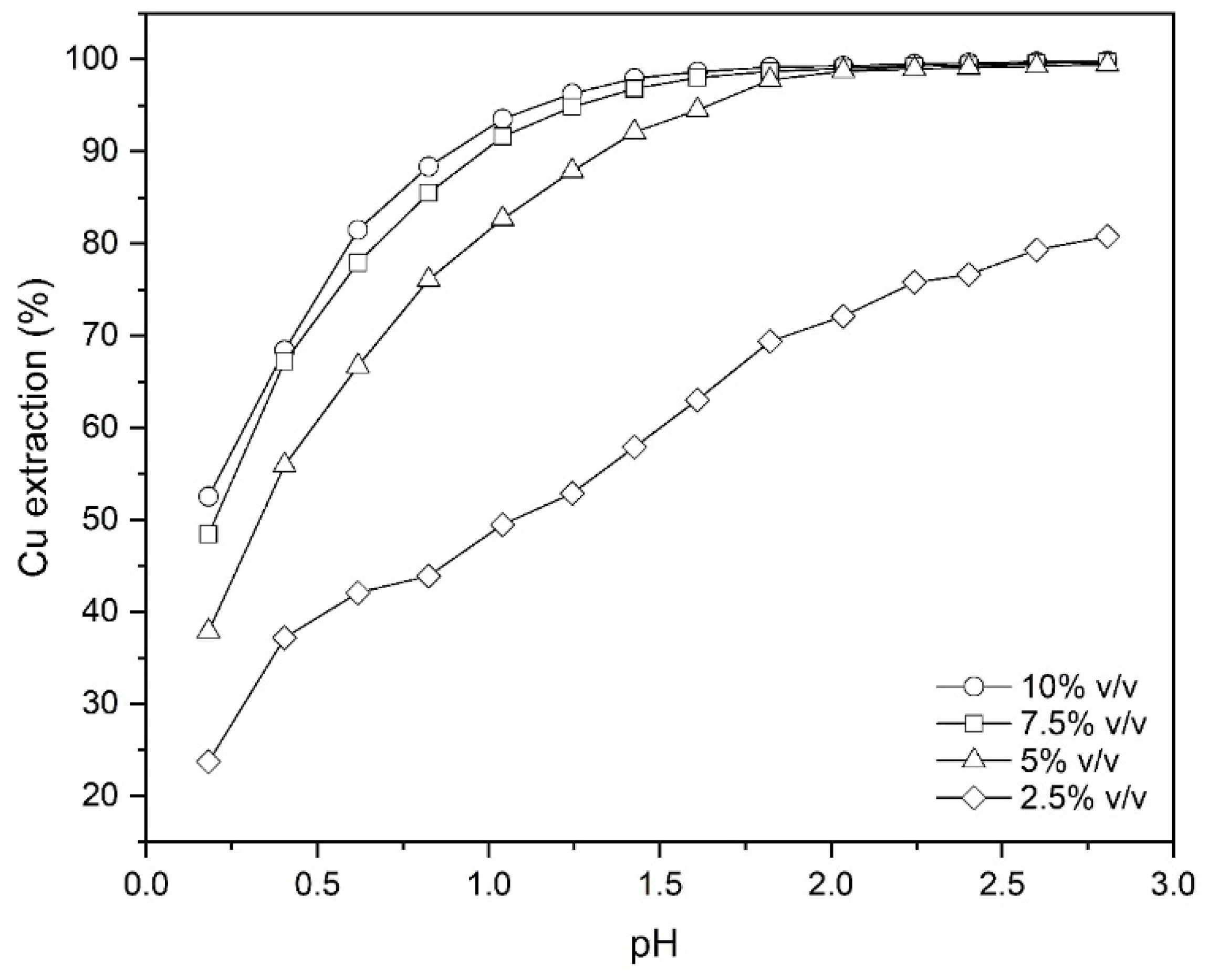
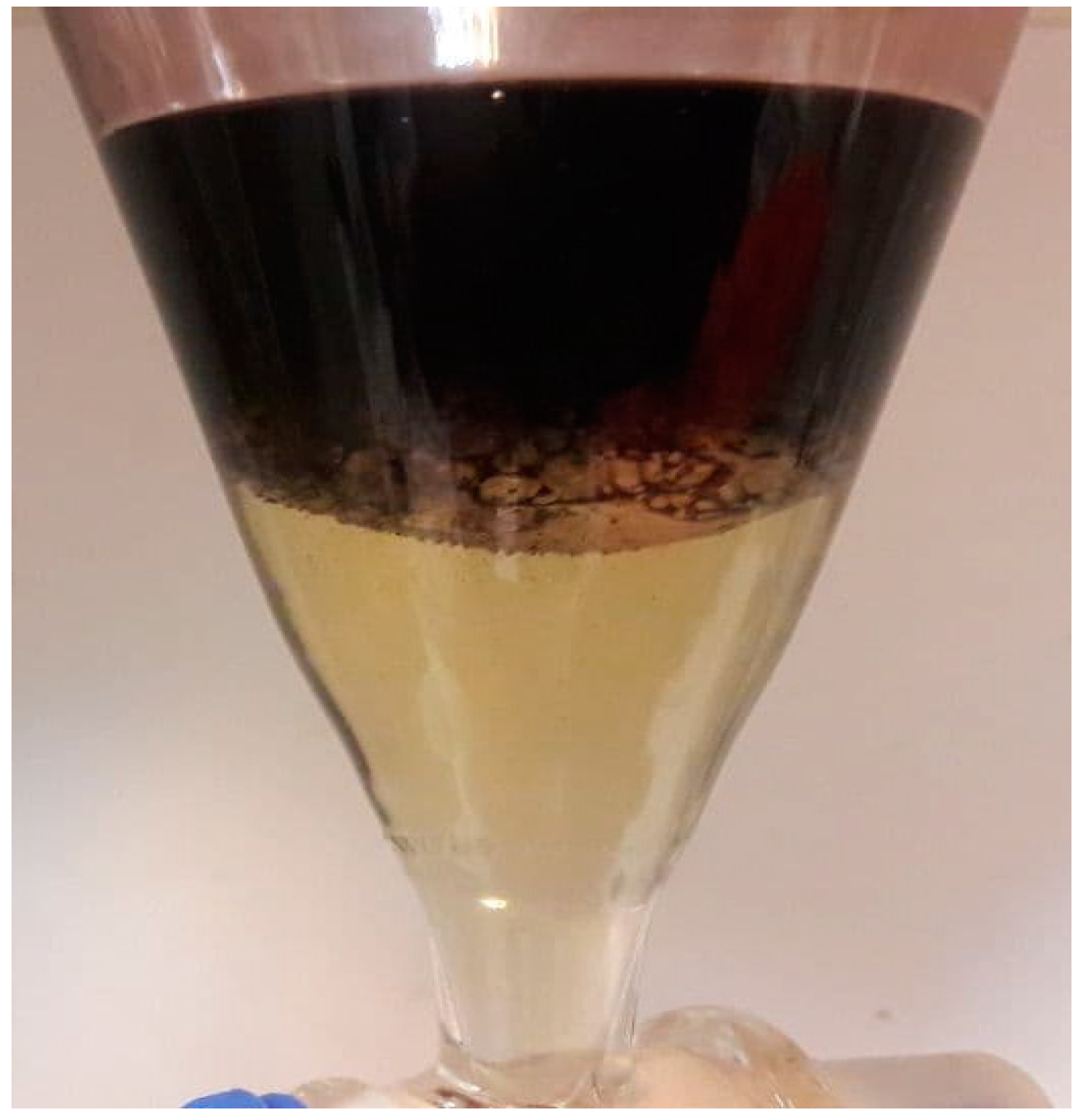
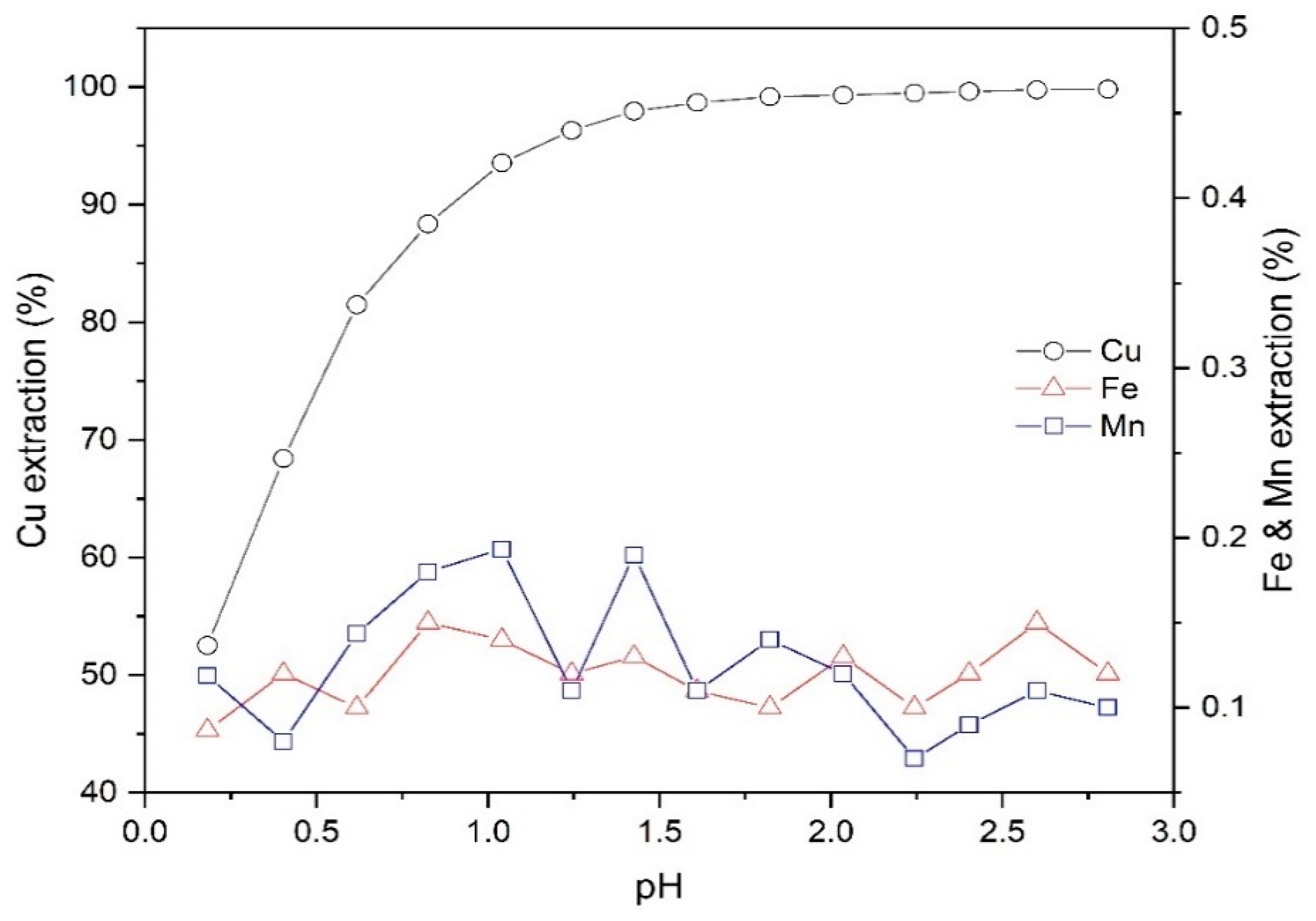

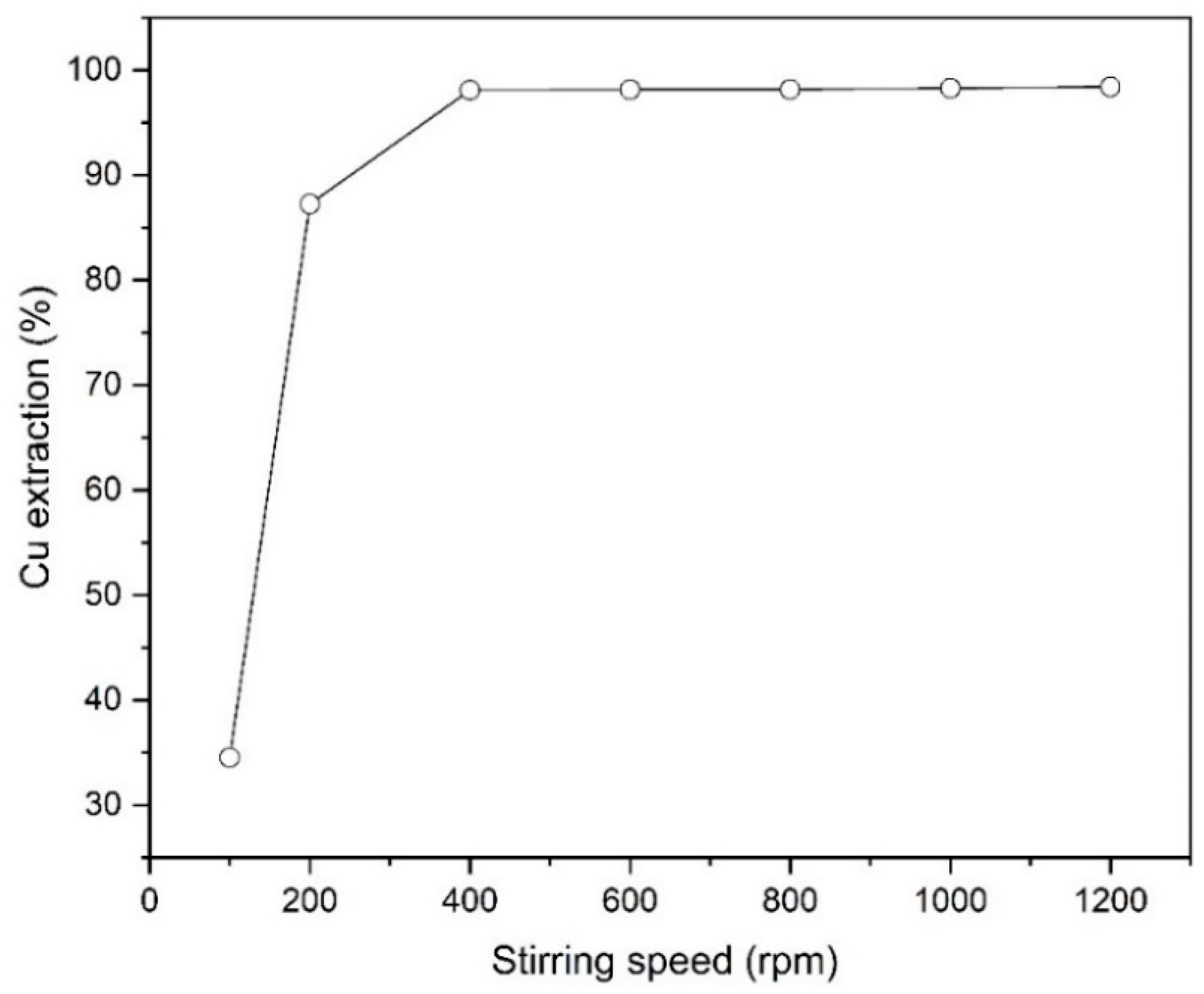

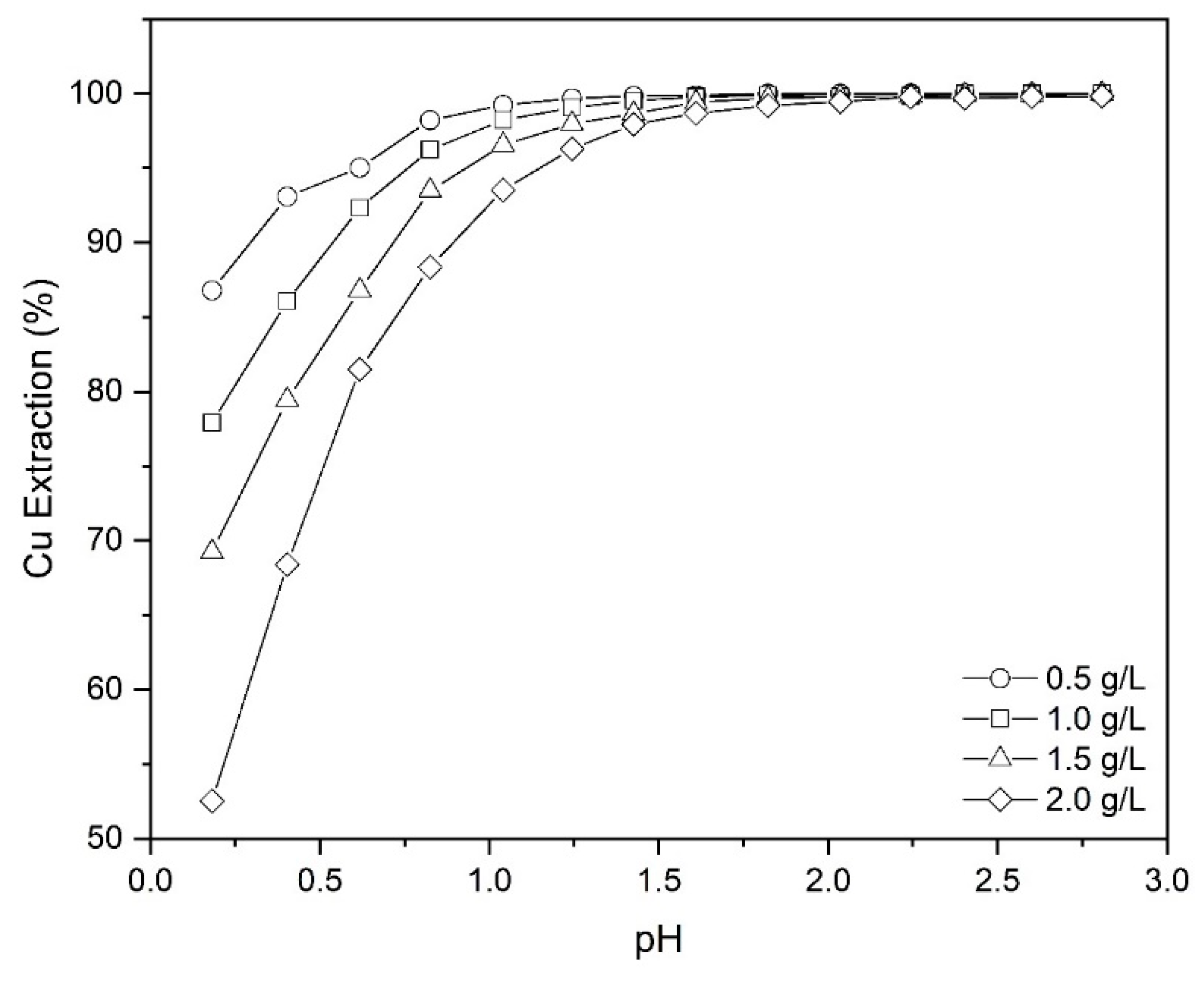
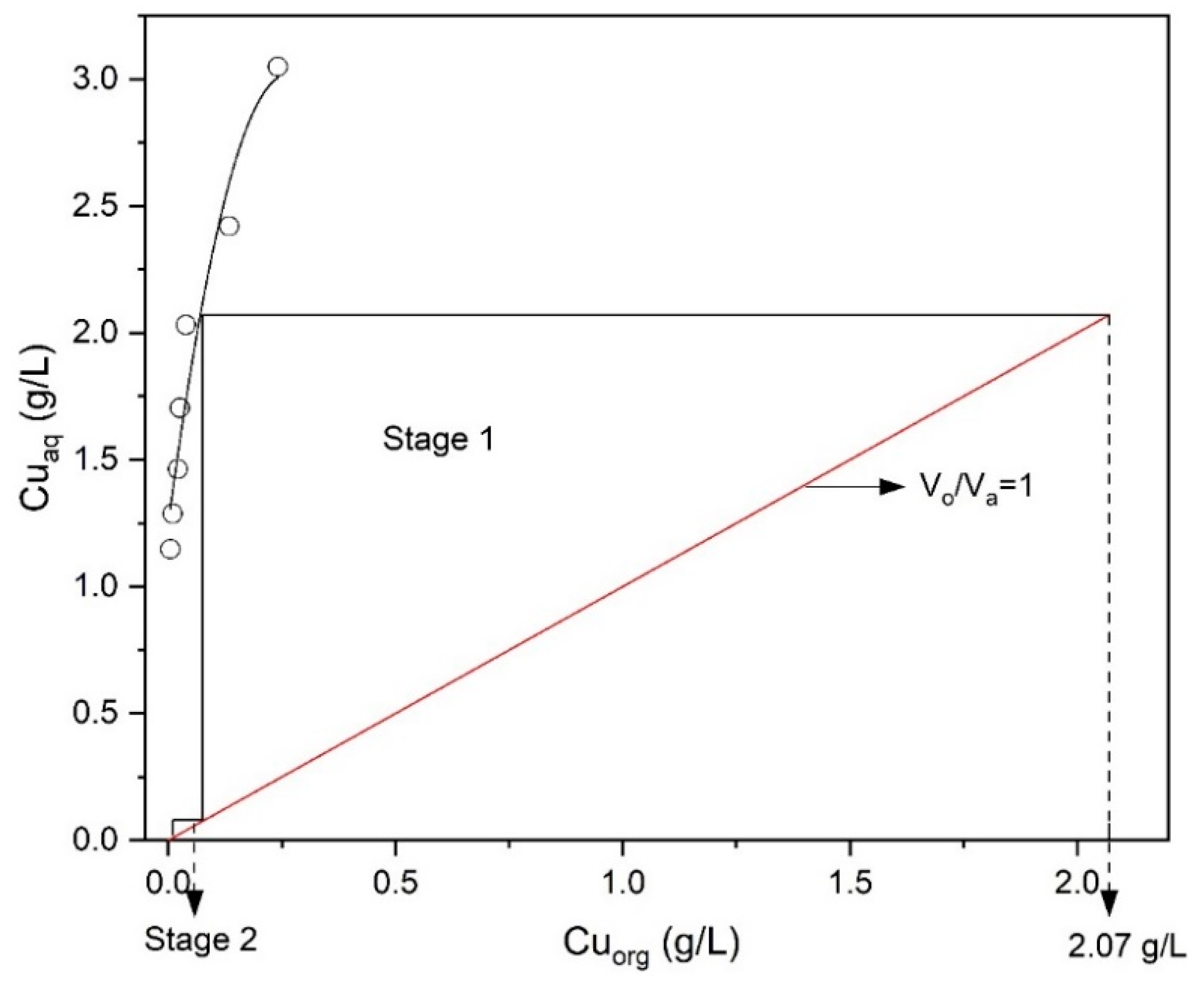


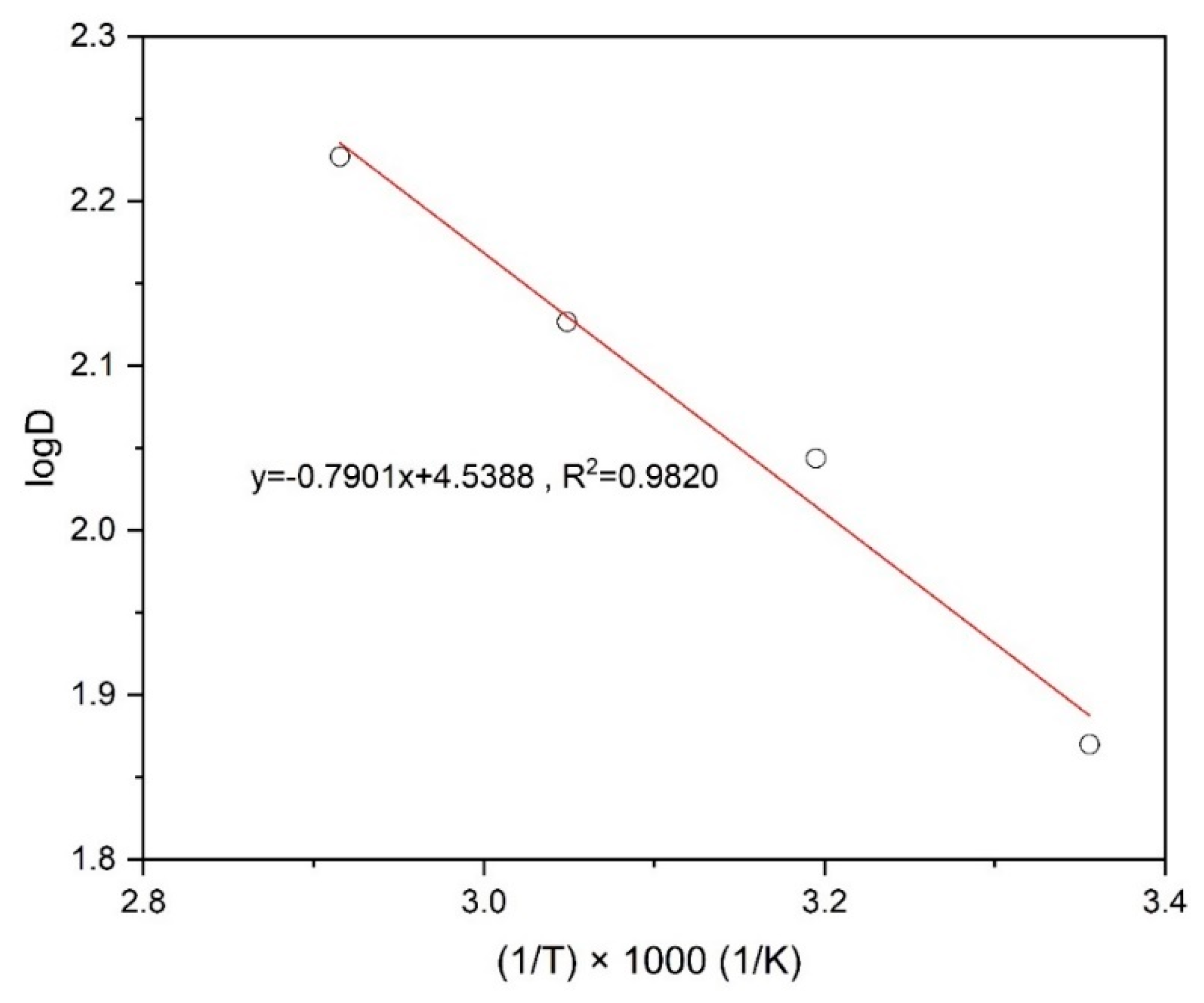
| Element | Al | As | Ca | Co | Cu | Fe |
|---|---|---|---|---|---|---|
| Content (mg/L) | 2030 | 109 | 4590 | 101 | 2070 | 2680 |
| Element | K | Mg | Mn | Ni | Pb | Zn |
| Content (mg/L) | 261 | 1730 | 3740 | 19.8 | 0.770 | 202 |
| pH | DCu | DFe | DMn | βCu/Fe | βCu/Mn |
|---|---|---|---|---|---|
| 0.2 | 1 | 0.095 | 0.135 | 12 | 8 |
| 0.4 | 2 | 0.136 | 0.087 | 16 | 25 |
| 0.6 | 4 | 0.111 | 0.168 | 40 | 26 |
| 0.8 | 8 | 0.176 | 0.220 | 43 | 35 |
| 1.0 | 14 | 0.163 | 0.240 | 89 | 60 |
| 1.2 | 26 | 0.136 | 0.124 | 191 | 210 |
| 1.4 | 47 | 0.149 | 0.235 | 318 | 202 |
| 1.6 | 74 | 0.124 | 0.124 | 600 | 600 |
| 1.8 | 120 | 0.111 | 0.163 | 1080 | 737 |
| 2.0 | 141 | 0.149 | 0.136 | 945 | 1036 |
| 2.2 | 195 | 0.111 | 0.075 | 1757 | 2593 |
| 2.4 | 273 | 0.136 | 0.099 | 2003 | 2762 |
| 2.6 | 409 | 0.176 | 0.124 | 2317 | 3308 |
| 2.8 | 551 | 0.136 | 0.111 | 4041 | 4959 |
| Thermodynamic Parameters | Values |
|---|---|
| ΔH kJ/mol | 15.1 |
| ΔG kJ/mol | −6.95 |
| ΔS J/mol/K | 74.1 |
| Extractant | Leaching Solution | Extraction Conditions | Result of Extraction | Reference |
|---|---|---|---|---|
| CuPRO MEX-3302 | Sulfate leach solution containing Cu, Fe and Mn | Extractant concentration = 5% (v/v), O/A phase ratio = 1:1, contact time = 3 min, pH = 2.1 and temperature = 25 °C | 95% Cu with Fe and Mn content less than 2% | [6] |
| LIX 84 and LIX 973N | Sulphate leach liquors of synthetic Cu–Ni–Co–Fe matte | Extractant concentration = 40% (v/v) and O/A phase ratio = 1:1 | 83% Cu by LIX 84 and 95% by LIX 973N with residual content less than 2 mg/L. | [8] |
| LIX 984 | synthetic and industrial solutions | Extractant concentration = 10% (v/v), O/A phase ratio = 1:1, contact time = 3 min, pH = 2–3 and temperature = 28 °C | 85% and 77% of Cu from synthetic and industrial solutions, respectively. | [18] |
| LIX 984 N | Bioleaching solution containing | Extractant concentration = 20% (v/v), O/A phase ratio = 1:1, contact time = 4 min, pH = 1.5, stirring rate = 400 rpm and temperature = 25 °C | 96% Cu at two stages counter-current extraction | [27] |
| LIX 84I and LIX 622N | Waste heat boiler dust leach liquor | Extractant concentration = 30% (v/v), O/A phase ratio = 1:1, contact time = 3 min, pH = 3.5 and room temperature | About 80.8% Cu with LIX 622N and 69.4% Cu with LIX 84I. | [28] |
| Mextral 5640H | Sulfate leach liquor | Extractant concentration = 10% (v/v), O/A phase ratio = 1:1, contact time = 2 min, pH = 1.6, stirring rate = 400 rpm and temperature = 25 °C | 98.17% Cu with a value of Fe and Mn < 0.5%. | Present work |
Publisher’s Note: MDPI stays neutral with regard to jurisdictional claims in published maps and institutional affiliations. |
© 2022 by the authors. Licensee MDPI, Basel, Switzerland. This article is an open access article distributed under the terms and conditions of the Creative Commons Attribution (CC BY) license (https://creativecommons.org/licenses/by/4.0/).
Share and Cite
Hosseinzadeh, M.; Petersen, J.; Azizi, A. Solvent Extraction Studies of Copper from a Heap Leach Liquor Using Mextral 5640H. Minerals 2022, 12, 1322. https://doi.org/10.3390/min12101322
Hosseinzadeh M, Petersen J, Azizi A. Solvent Extraction Studies of Copper from a Heap Leach Liquor Using Mextral 5640H. Minerals. 2022; 12(10):1322. https://doi.org/10.3390/min12101322
Chicago/Turabian StyleHosseinzadeh, Mostafa, Jochen Petersen, and Asghar Azizi. 2022. "Solvent Extraction Studies of Copper from a Heap Leach Liquor Using Mextral 5640H" Minerals 12, no. 10: 1322. https://doi.org/10.3390/min12101322
APA StyleHosseinzadeh, M., Petersen, J., & Azizi, A. (2022). Solvent Extraction Studies of Copper from a Heap Leach Liquor Using Mextral 5640H. Minerals, 12(10), 1322. https://doi.org/10.3390/min12101322







